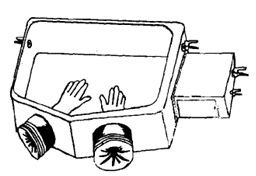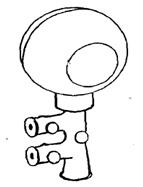Precautionary Measures Against Ionising Radiations
The following guidelines are suggested for experiments using low activity radioactive materials:
(1) Avoid skin contact by:
(a) wearing protective gloves (disposable polythene gloves over a rubber pair are convenient) and a lab coat.
(b) transferring chemicals in a fume cupboard or in a manipulator glove box with a spatula or forceps.
(c) using safety bulbs when pipetting radioactive substances. Do not lick any labels.

Figure: An isolation and manipulation

Figure: A pipette filler.
Confine any work with radioactive materials to one area of the laboratory such as a fume cupboard and always set up warning signs. Glassware to be used for radioactive materials should be kept solely for this purpose and stored separately to guard against accidental contamination.
All bottles containing radioactive material should be labelled with the recognised symbol.
The person getting the radioactive material issued should put his signature along with full name and also the date and issuing time in the register.
Check the quantities of radioactive substances at the end of any work and account for all the material which has been used.
Return all sources and radioactive materials to a securely locked and suitably shielded cupboard in the stores. This cupboard should be properly labelled and used solely for storing radioactive materials. A special notebook should be kept for logging these radioactive sources in and out of storage. It should also indicate the type and serial number of the source.
Always wash your hands thoroughly using disposable towels after working with radioactive materials and then monitor with a Geiger counter to ensure that no radioactivity remains on the skin.
Use plenty of water if disposing of permitted quantities (up to 100 g) of uranium or thorium salts.
The radioactive materials used in industry are frequently more than a million times stronger than the demonstration materials in schools and colleges.